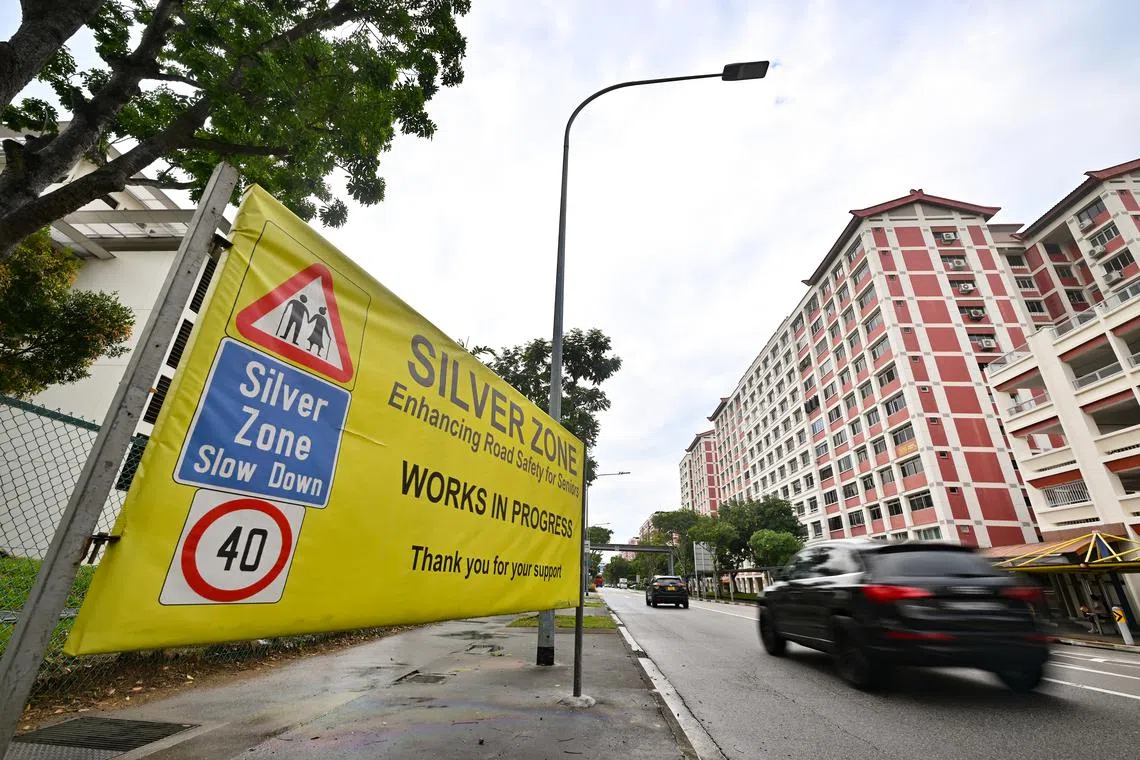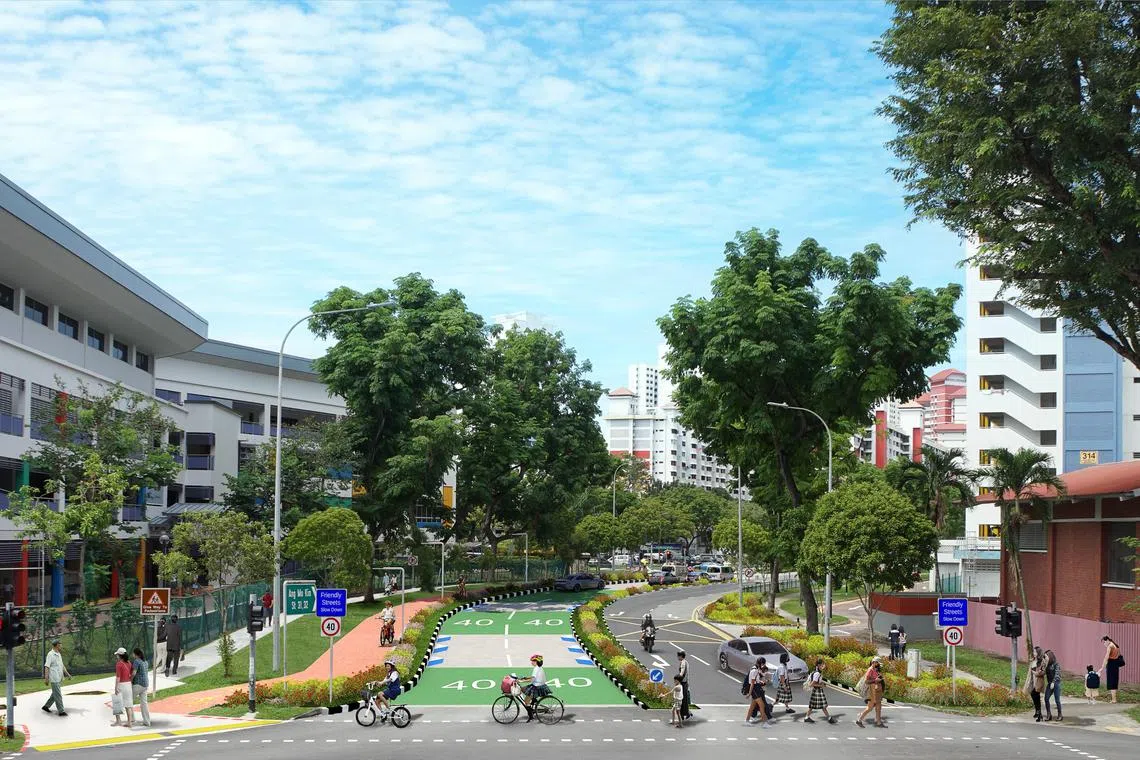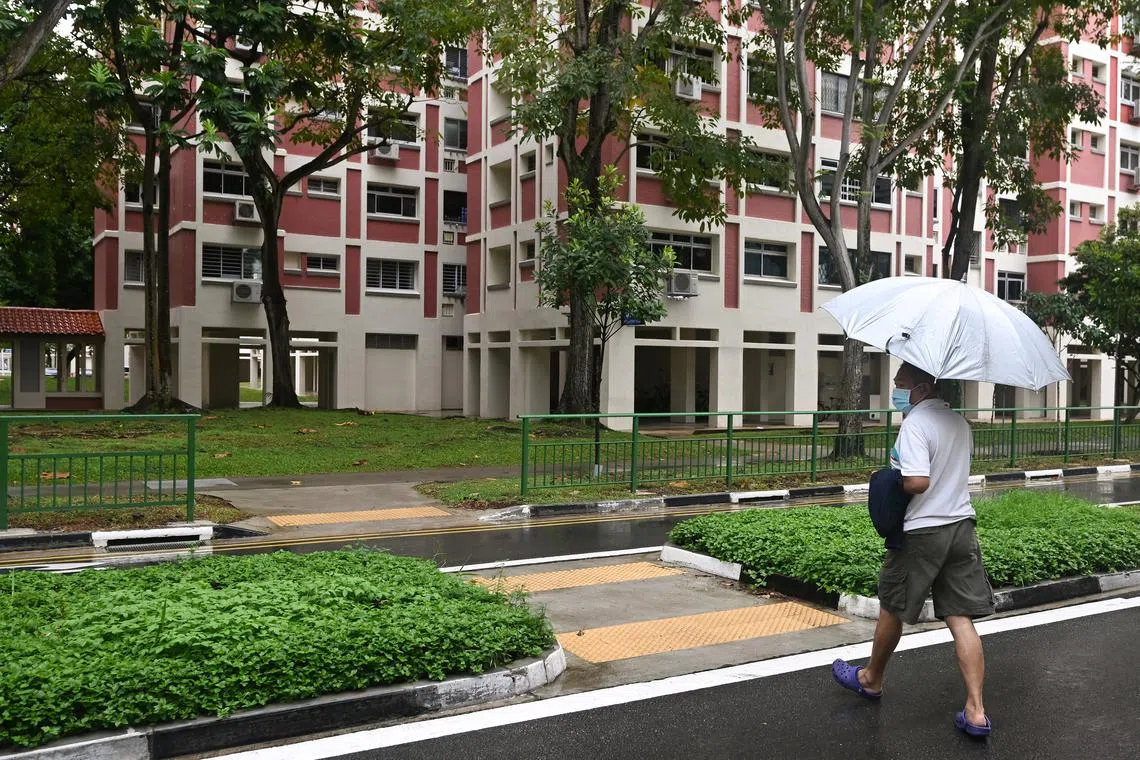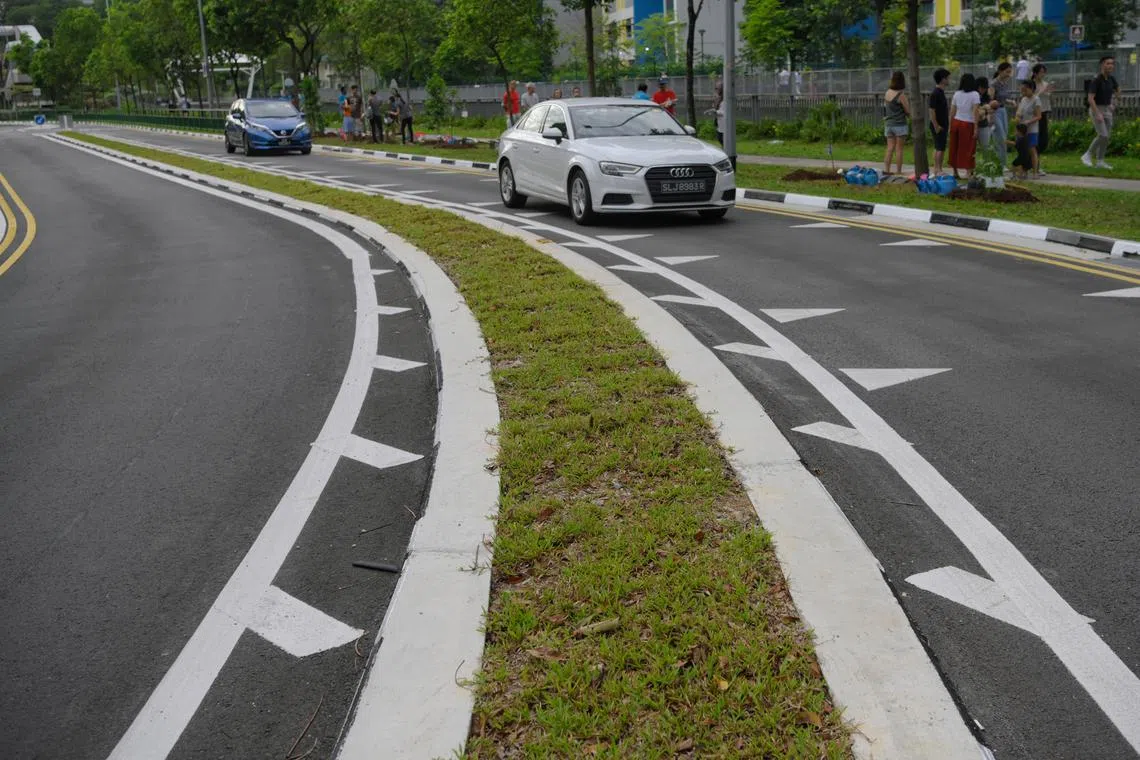30 Silver Zones completed to improve road safety for seniors; LTA on track for 50 by 2025
Sign up now: Get ST's newsletters delivered to your inbox

A Y-junction at the new Silver Zone in West Coast Drive. Y-junctions have a bend that slows motorists down when they approach the intersection.
ST PHOTO: MARK CHEONG
Follow topic:
SINGAPORE - Seniors living near West Coast Market and Ayer Rajah Food Centre will be able to walk around their neighbourhoods with greater peace of mind after road modifications to improve pedestrian safety were officially completed on Sunday.
An 800m stretch of Clementi West Street 2 and a 400m stretch of West Coast Drive have been designated Silver Zones, where the speed limit is reduced to 40kmh.
Measures in place include longer green-man timings, narrower road lanes and barrier-free crossings.
This takes the number of completed Silver Zones in Singapore to 30, said Transport Minister S. Iswaran at a community event marking the occasion.
He added that the Land Transport Authority (LTA) is well on track to meet its goal of finishing 50 such zones islandwide by 2025. Those in the pipeline include one that encompasses Tampines Street 32 and Street 33, which is expected to be ready by the end of July.

The Silver Zone that encompasses Tampines Street 32 and Street 33 is expected to be ready by the end of July.
ST PHOTO: LIM YAOHUI
To further improve safety, some Silver Zones have had their speed limits lowered from 40kmh to 30kmh, and LTA has plans to do this at more places.
The authority previously conducted a year-long trial in Bukit Merah View and Jurong West Street 52, and later lowered the speed limit in Commonwealth Drive, Lengkok Bahru, Jalan Tiong, Redhill Road, Potong Pasir Avenue 2 and Hougang Avenue 5 to 30kmh as well.
The plan is for Silver Zones in Lorong 8A Toa Payoh, Bedok North Street 3, Ang Mo Kio Street 61, Ang Mo Kio Street 32 and Serangoon Central Drive to also have a speed limit of 30kmh in future.
Mr Iswaran said: “We have a growing population of senior citizens, and we want to make sure all our roads, our streets, are friendly and convenient for all users.”
He added: “We have already launched an initiative called Friendly Streets, which really will build on what we have with our Silver Zones, to make it even broader in terms of the coverage and the way we are able to make our neighbourhoods more friendly and easier for all residents.”
Announced in March,
Features from school zones, Silver Zones and transit priority corridors will be used in concert to make streets that are close to key amenities and transport nodes less vehicle-centric.
LTA said it is in the process of forming a task force for each trial location, with community engagement to kick off in the next few months and works to start by the end of 2023.

Announced in March, the Friendly Streets initiative will be trialled in Ang Mo Kio, Bukit Batok West, Tampines, Toa Payoh and West Coast.
PHOTO: LTA
Redesigning streets for seniors
The Silver Zone scheme, which began in 2014, targets residential areas with a high population of seniors and higher accident rates involving old folk. The zones also tend to be close to amenities such as hawker centres and markets.
Each zone is unique, with features that vary by location.
Mr Andrew Tan, a senior manager for road safety projects at LTA who has been involved with the Silver Zone scheme from its inception, said the lower speed limit at Silver Zones makes it safer for LTA to try out new measures to create a better road environment.
Y-junctions, for instance, were added to LTA’s toolkit only a few years ago, after Mr Tan noticed similar junctions being used in residential areas in Australia when he was there.
These are similar to T-junctions, but have a bend that slows motorists down when they approach the intersection.
Mr Tan, 35, said a Silver Zone typically takes 12 to 18 months to be completed.
Once the location is identified, LTA engineers go to the site to monitor the crossing patterns of pedestrians, the travelling speed of motorists and traffic volumes.
Using these detailed traffic assessments, the LTA team looks at where to add more crossing points and where motorists need to slow down.
It then decides on the appropriate measures to implement, based on the specific needs and constraints of each site.
“For example, there may be a location where a lot of motorists make illegal U-turns,” Mr Tan said.
“If there is an opportunity to formalise it as a legal U-turn point, we might want to construct a roundabout to facilitate this demand,” he added.
Measures that have been implemented at earlier Silver Zones are also reviewed to refine their designs.
For instance, earlier versions of kerbless road crossings had concrete bollards, “Look” road markings and imprints. But these were removed for later iterations, and the LTA team found that pedestrians paid more attention to the traffic before they used such crossings.

A new kerbless road crossing in Tampines Street 33.
ST PHOTO: LIM YAOHUI
Community feedback
LTA has also increased its engagement with local communities to take in their views, Mr Tan said.
This happens before and during a Silver Zone’s design stage, and throughout the construction process.
One example of this is how shrubs and other plants are now being used to guide pedestrians to certain crossing points within Silver Zones, in place of the usual metal railings.
On lowering the speed limit at Silver Zones to 30kmh, Mr Tan said doing this for all Silver Zones would increase safety, but whether it is effective depends on the traffic-calming features that can be implemented at each location.
“We want to be sure that the reduced speed limit we are proposing is realistic... If we do not do it correctly with the complementary measures, you may eventually end up with a situation where the speed limit is 30kmh, but motorists still travel at 50kmh,” he added.

Traffic-calming markers at the new Silver Zone in Clementi West Street 2.
ST PHOTO: MARK CHEONG
Mr Tan said his team constantly monitors the traffic speeds at Silver Zones that have already been completed to see if there are possibilities to lower the speed limit at these places.
If the local community is already supportive of a 30kmh speed limit during the design stage of an upcoming Silver Zone, LTA can implement the lower speed limit from the outset, he added.
With the Silver Zone scheme approaching its 10th year, Mr Tan said he feels a sense of achievement when he tabulates the accident rates at completed Silver Zones and finds that accidents involving seniors have gone down.
The authorities have said that the overall accident rate for senior pedestrians across Silver Zones here has fallen by 80 per cent.
Mr Tan added: “I wouldn’t say we have totally succeeded in changing motorist behaviour islandwide, but, more or less, motorists who have travelled within our Silver Zones would have adapted.”
In West Coast, resident Edmund Tan, 66, said he has noticed that motorists are travelling slower along West Coast Drive after changes were made to the road infrastructure there under the Silver Zone scheme.
Adding that road users need to give senior pedestrians a lot more consideration, he recounted a past incident where he was nearly hit by a car that was turning out from a carpark onto the main road at a high speed.
The retired civil servant, who drives, said: “As motorists, we must be prepared to slow down. If we continue to drive the way we used to, when roads were built much wider, the outcome is that you might knock a lot more people down.”
Mr Iswaran made a similar point to his West Coast constituents on Sunday.
He said: “All of this works only when we have the cooperation of residents and, importantly, all road users... Everyone has to be very gracious, courteous and conscious of road safety.”



